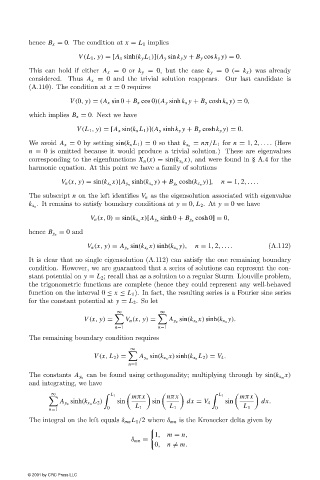Page 498 - Electromagnetics
P. 498
hence B x = 0. The condition at x = L 1 implies
V (L 1 , y) = [A x sinh(k y L 1 )](A y sin k y y + B y cos k y y) = 0.
This can hold if either A x = 0 or k y = 0, but the case k y = 0 (= k x ) was already
considered. Thus A x = 0 and the trivial solution reappears. Our last candidate is
(A.110). The condition at x = 0 requires
V (0, y) = (A x sin 0 + B x cos 0)(A y sinh k x y + B y cosh k x y) = 0,
which implies B x = 0. Next we have
V (L 1 , y) = [A x sin(k x L 1 )](A y sinh k y y + B y cosh k y y) = 0.
= nπ/L 1 for n = 1, 2,.... (Here
We avoid A x = 0 by setting sin(k x L 1 ) = 0 so that k x n
n = 0 is omitted because it would produce a trivial solution.) These are eigenvalues
x), and were found in § A.4 for the
corresponding to the eigenfunctions X n (x) = sin(k x n
harmonic equation. At this point we have a family of solutions
y)], n = 1, 2,....
V n (x, y) = sin(k x n x)[A y n sinh(k x n y) + B y n cosh(k x n
The subscript n on the left identifies V n as the eigensolution associated with eigenvalue
. It remains to satisfy boundary conditions at y = 0, L 2 .At y = 0 we have
k x n
cosh 0] = 0,
V n (x, 0) = sin(k x n x)[A y n sinh 0 + B y n
= 0 and
hence B y n
y), n = 1, 2,.... (A.112)
V n (x, y) = A y n sin(k x n x) sinh(k x n
It is clear that no single eigensolution (A.112) can satisfy the one remaining boundary
condition. However, we are guaranteed that a series of solutions can represent the con-
stant potential on y = L 2 ; recall that as a solution to a regular Sturm–Liouville problem,
the trigonometric functions are complete (hence they could represent any well-behaved
function on the interval 0 ≤ x ≤ L 1 ). In fact, the resulting series is a Fourier sine series
for the constant potential at y = L 2 . So let
∞ ∞
V (x, y) = V n (x, y) = A y n sin(k x n x) sinh(k x n y).
n=1 n=1
The remaining boundary condition requires
∞
V (x, L 2 ) = A y n sin(k x n x) sinh(k x n L 2 ) = V 4 .
n=1
x)
The constants A y n can be found using orthogonality; multiplying through by sin(k x m
and integrating, we have
∞ L 1 L 1
mπx nπx mπx
L 2 ) sin sin sin dx.
A y n sinh(k x n dx = V 4
n=1 0 L 1 L 1 0 L 1
The integral on the left equals δ mn L 1 /2 where δ mn is the Kronecker delta given by
1, m = n,
δ mn =
0, n = m.
© 2001 by CRC Press LLC

